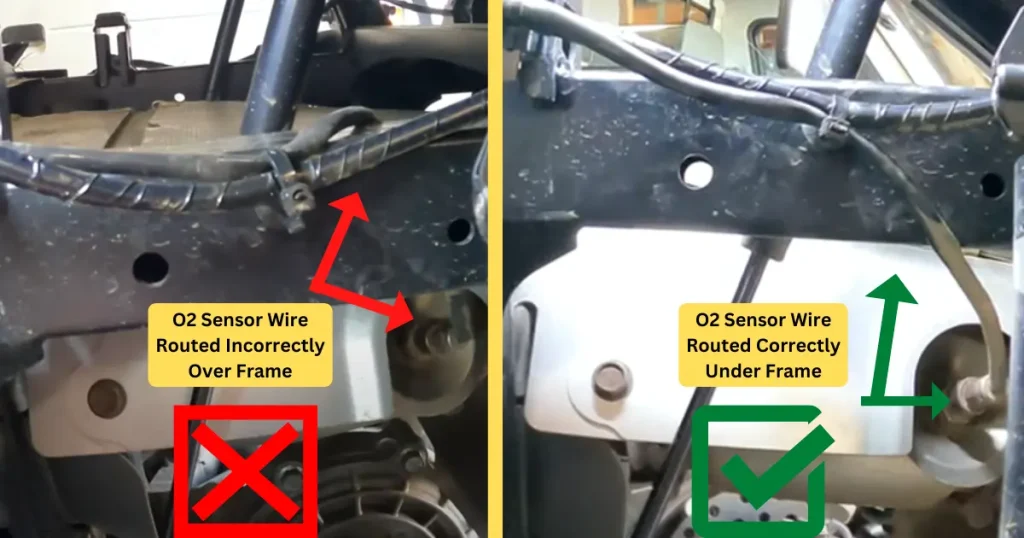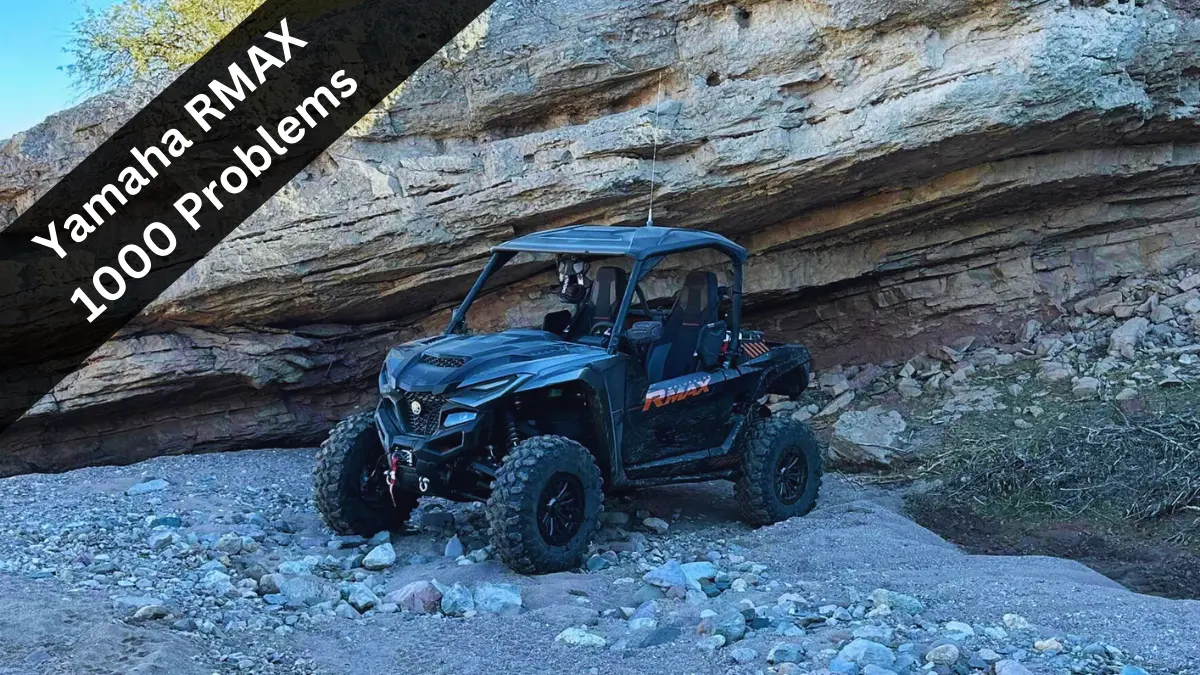As Yamaha’s recreational side-by-sides, the RMAX 1000 (Wolverine) models offer one of the better blends of utility and recreation across the industry.
These models are some of the most well-rounded Yamaha models since the criminally underrated Yamaha Rhino 660 made its debut many years ago.
And like the Rhino 660 still makes for one of the best cheap used side-by-sides today, the RMAX 1000 is right up there with some of the best present-day UTV values in the industry.
But the Yamaha RMAX models aren’t without their flaws, as they’re affected by six common problems known to drive owners a bit mad. These include:
- The dreaded axle click
- O2 sensor wire installed wrong
- Extreme engine noise
- Squeaky and stiff brakes
- Overheating
- Poor gas mileage
Each problem will be detailed in this guide, along with proven fixes.
The Dreaded Axle Click
This problem is prevalent enough that it’s been given its own name – The Dreaded Axle Click – by owners in the Yamaha Wolverine RMAX Facebook Group.
Over time, the RMAX has a tendency to begin making a clicking and clunking noise that comes from the rear, most often when you turn to the right or left.
This noise is coming from the rear axles, and while it’s fairly common, it shouldn’t be considered normal and can be extremely annoying to deal with after paying top dollar for this vehicle.
Yamaha should cover this problem under warranty when it happens, but there’s still a problem.
The factory axles are the issue, and the problem will likely start happening again before too long.
Fixes
There’s a short-term fix, and a long-term fix for this:
- Replace the rear axles
- Apply grease to the axle boots
Replace The Rear Axles
The best fix for this is to replace your rear axles with Cobra HD Yamaha RMAX axles, which will eliminate the clicking and make for a better ride overall.
Not cheap, but worth it if you have the budget.
Apply Grease To Axle Boots
To make a short-term fix for this, you’ll need to take matters into your own hands or work with your dealer to do so.
Luckily, you don’t have to have experience as a mechanic to overcome this issue. But you will need a grease gun and a needle greaser attachment for it.
Stick the needle greaser into each axle boot, and apply around ten pumps of grease into each one.
Be sure that when applying the grease you point the needle away from the fold points inside and outside and apply it on a flat portion.
After applying the pumps of grease, pinch a small dab of super glue into each needle hole.
This should stop the clicking temporarily, and you may need to repeat the process when it happens again.
O2 Sensor Wire Recall
In late 2021, Yamaha put out a recall bulletin regarding the O2 sensor wire in some Yamaha RMAX 1000’s.
This recall stated that there is a possibility the O2 wire sensor was inadvertently installed wrong, which leaves the wires at more exposure to damage from mud and dirt during normal use.
This could lead to a short-circuit condition where the engine could stall due to a failed ignition fuse.
Failure could also cause the vehicle’s exhaust emissions to rise above EPA certification levels.
Fix
Owners should inspect the O2 sensor wire to ensure it is routed under the frame correctly.

If it is routed over the frame or through one of the frame holes, this is wrong and the wiring will need to be rerouted to avoid potential issues.
This recall is covered by Yamaha and your dealer, but is easy enough that some owners have made the repair themselves.
Extreme Engine Noise
Powered by a 999 cc beast of an engine, you’d expect some engine noise as a tradeoff for all of that power.
But the engine noise in the RMAX 1000 is extreme, to the point that some younger riders have been known to cover their ears and complain after a few minutes.
This engine noise is amplified due to reverberation off the many plastic parts that make up and enclose the machine, and gets worse the faster you go.
This is also a problem in the Yamaha Viking models.
Fixes
There are a number of ways to attempt to drown out this noise.
Some owners have resorted to using earplugs when riding, while others use helmets or headsets that help to dampen the sound.
But the best solution seems to be installing sound deadening mats in the following areas:
- Back panels near the motor
- Inside of the console
- Under and behind the seats
- Underside of any removable plastic coverings
This should help to muffle the engine noise enough so that you can carry on a conversation with your passengers and it’s not so ear bursting for younger riders.
But at the end of the day, if you are in the market for an RMAX 1000, you need to be prepared for a pretty loud ride.
Squeaky and Stiff Brakes
The brakes on the RMAX 1000 are another source of frustration among owners for a couple of different reasons.
Squeaking
The most common issue with the brakes is the tendency for them to squeak loudly while driving.
This squeaking can happen even when not applying them, which can be noisy and annoying when out for a drive.
Fortunately, this can usually be overcome with some white lithium grease. For the best results, take the brake calipers apart and remove the pins, applying grease to both.
Then apply grease to the clips that hold the brake pads in, as well as to the back side of the brake pads.
This should have your machine running quiet as a mouse, but the process may need to be repeated every so often if the squeaking recurs.
Stiffness
The second common issue is that the RMAX 1000’s brakes are often incredibly stiff on newer units, leaving owners needing to exert more than the usual amount of pressure to properly stop their vehicles.
This stiffness is likely due to the brake pads coming coated from the factory.
Once the coating wears off, which is generally after 100 or so miles of driving, the stiffness should mostly subside.
But for folks who don’t want to wait that long, bleeding the brake fluid reservoir and then adding new brake fluid may help to resolve this problem faster.
Overheating
Yamaha engines are some of the best in the UTV industry, but they do have a tendency to overheat for a few different reasons:
- Clogged Radiator
- Radiator Fan
- Air Blockage in Coolant System
- Blown Head Gasket
Clogged Radiator
The RMAX is a beast off-road, so its radiator is likely constantly subjected to elements like mud, dirt, grass, and sand over time while you trail ride.
This leads to the radiator fins and grill becoming clogged, which contributes to overheating.
Be sure and wash out your radiator fins after any ride through muddy conditions to ensure they’re not becoming clogged.
And you should remove your grill from time to time for a good soak in a cleaner like Simple Green, spraying it out with a hose afterwards.
Radiator Fan
The radiator fan is programmed not to engage until the engine reaches temps of around 208 degrees.
If you’re riding in warm climates or at higher elevations, especially while in Low gear for prolonged periods, the fan may not trigger in time to keep the engine temp from continuing to rise past dangerous levels and overheating.
Aside from cleaning your radiator constantly, the best way to combat this is to have your ECU tuned.
An ECU tune usually comes along with the added benefit of lowering the temperature at which the fan engages to 190 degrees or so, which gives it that much more time to control the engine temp.
Airlock In Coolant System
If your RMAX is overheating, you may have an air pocket in your coolant system.
An air pocket can form any time the engine gets close to overheating, and it will block the coolant from pumping properly.
This will lead to overheating until the air is bled from your coolant system by “burping” your RMAX.
A Blown Head Gasket
A blown head gasket is another common cause of overheating in these models.
A head gasket can go poof any time your engine overheats, and when this happens it will lead to recurring overheating.
Use a head gasket test kit to confirm this and replace if needed.
Poor Gas Mileage
Another con of the RMAX 1000 is that it gets poor gas mileage, especially in low gear.
If riding in rough terrain solely in low gear, a full tank of gas will not likely last more than 60 miles.
While tackling easier terrain in high gear is a little better, a full tank will still only last around 80 to 90 miles.
Prepare to refill often in this gas guzzler.
Conclusion
Even the biggest-names side-by-sides and ATVs will experience their own sets of common problems, and the RMAX 1000 is no different here.
Either way, the RMAX 1000 makes for one of the best recreational/utility blends you’ll find, though it can’t quite keep up with some of the fastest side-by-sides in the industry.


